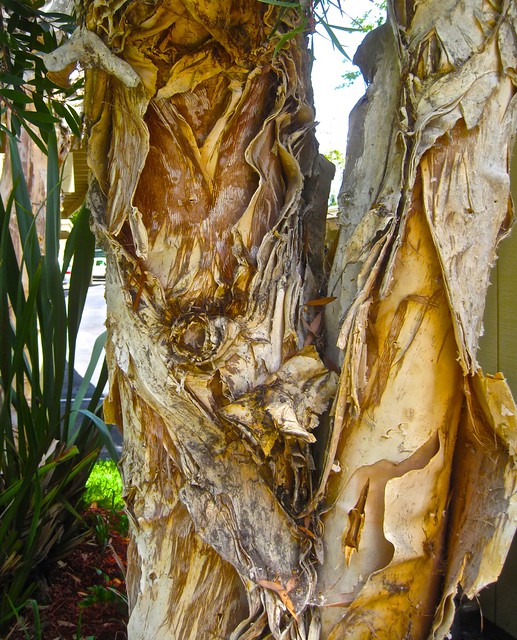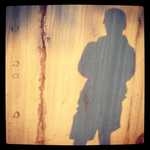A sunny afternoon picnic under a stand of Australian Melaleuca trees.
As a strictly amateur botanist, I suspect that the trees above may be Melaleuca quinquenervia, which constitutes an invasive pest in Florida but not apparently in the drier California climate. This type of Melaleuca, known as a “Paperbark,” has very soft bark, thrilling to touch, that can be stripped off in thin sheets. The tree has lots of uses. For example, Tea Tree Oil is recommended for a number of skin complaints and is known to have antiseptic properties. Aboriginal Australians apparently chewed the young leaves as a headache remedy, although Tea Tree oil is labelled as poisonous to drink.
Most Californians know about all the Australian Eucalypts planted seemingly everywhere in CA, literally by the millions since 1853, but many are not aware of just how many different Australian species, like the Melaleuca, now call California home. Just so ya know, here is a list of common examples of Australian genera (each of which includes numbers of separate species) now grown in CA. See Monterey Bay Nursery Website. In my own garden in Australia, I grow at least 15 of the following genera, including about 8 different species of the Callistemon genus, 2 of Correa, 5 Acacia, 15 Eucalyptus, 3 Scaevola, several Banksia, and at least 20 varieties of Grevillea.
Acacia, Adenanthos, Alyogyne, Anigozanthus, Astartea, Banksia, Baumea, Boronia Callistemon, Chamelaucium, Correa, Cyathea, Dianella, Dicksonia, Doodia, Eriostemon Eucalyptus, Grevillea, Hardenbergia, Hypocalymma, Leptospermum, Melaleuca, Myoporum Nephrolepis, Pandorea, Pittosporum, Scaevola, Scleranthus, Sollya, Syzigium, Tristaniopsis, Westringia
I plan to do a few Hi sketches on interesting Australian plant families, but here I will just tell a story focusing on the concept of ‘native’ plants as opposed to ‘introduced’ species. Most people understand this distinction very well, but as the story indicates, not everyone grasps the concept.
In 1974 I spent nearly five months in Beijing, occasionally traveling into more remote regions, visiting places like Mao’s revolutionary bases and the Red Flag Canal region, famous for its achievements during the Great Leap Forward. On these forays, my wife and I were accompanied by an Interpreter and a Guide. We liked the Interpreter, an interesting young woman, well educated, and with excellent English. One day, when I remarked on how interesting it was to see Eucalyptus and Melaleuca growing in China, the Interpreter expressed her surprise that I could name the species.
“Oh, but they’re Australian”, I said.
“Of course not”, she quickly (and I thought harshly) responded. “How could you think such a thing?”
“But they are, they definitely are Australian.” I returned rather weakly.
“They belong to the Chinese people!”
“Oh” (a light dawning), “of course, they do, but they are indigenous to Australia.”
“No, they are not Australian. These plants grow in many parts of China.”
“Yes, but they originally came from Australia. They were first brought to China during the Qing Dynasty.”
“You mean you believe that these trees . . . were brought here from Australia . . . during the Qing Dynasty?”
“Well, perhaps not these specific trees” I conceded.
My notes don’t say how the conversation ended. But don’t forget that 1974 was the tail end of the Cultural Revolution. I remember eyes in the room narrowing.
Filed Under
Other moments in Dana Point
-
Dark Night of the Soul - an excerpt
in Dana Point, United States -
writing, Writers
A Writer's LIfe
in Dana Point, United States -
Back in Time
in Dana Point, United States -
writing
Writing...z-z-z-z
in Dana Point, United States -
Thoughts
Lost
in Dana Point, United States -
Fiction
Excerpt - Midnight Omen Deja vu
in Dana Point, United States -
writing, Books, Imagination
Books are the Stairway to the Imagination
in Dana Point, United States -
Life
"Life may not be the party we hoped for but while we are here, we might as well dance!"
in Dana Point, United States -
Full Moon
Full Honey Moon
in Dana Point, United States











